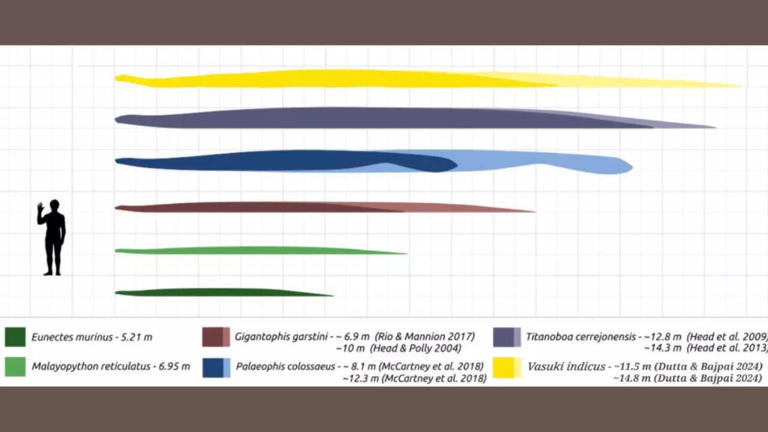Bogotá: In the silent shadows of prehistoric Earth, a reptilian colossus once ruled the swamps and rainforests of ancient South America — a serpent so massive and powerful, it seems almost fictional. But Titanoboa cerrejonensis was no myth. Discovered in Colombia’s Cerrejón coal mine, this gargantuan snake is now regarded as the largest snake to have ever lived — and scientists are still reeling from its size, power, and, surprisingly, its diet.
Stretching up to 47 feet in length and weighing over a ton, Titanoboa thrived approximately 58 to 60 million years ago, in the Paleocene epoch, shortly after the extinction of the dinosaurs. The fossil remains, first unearthed in 2009, have transformed our understanding of prehistoric ecosystems and the environmental conditions of that time.
A Glimpse Into the Ancient World
Unlike venomous modern snakes, Titanoboa killed with pure muscle. Drawing eerie parallels with today’s boas and anacondas, it likely used constriction to suffocate its prey.
“Huge muscles wrap around the prey item… and feel the expansion of their ribcage as the animal struggles to breathe”, states the original fossil study. “At the end of every breath, with the lungs empty, the snake contracts its muscles a little more, tightening its grip and inching the prey closer to the point of no return”.
A Shocking Twist in Its Diet
Though its size suggested a predator capable of devouring large land animals, recent fossil findings shocked scientists. Fragments of the snake’s jaw and skull painted a different picture — one not of dry land, but water.
The configuration of Titanoboa’s teeth, loosely set and adapted for gripping, indicated it fed primarily on fish, making it an apex predator in the swampy aquatic habitats of ancient Colombia. This unexpected diet aligned with its likely semi-aquatic lifestyle, similar to that of today’s anacondas.
Reconstructing a Monster
The discovery of new cranial fragments — including parts of the braincase and palate — allowed scientists to reconstruct its head, which measured around 16 inches, much larger than previously estimated. These new measurements also extended the snake’s projected full body length from 42 to 47 feet, cementing Titanoboa’s place in the record books.

A Window into a Hotter, Wilder Earth
Titanoboa’s tremendous size did more than just stun scientists; it also helped them unlock secrets of Earth’s ancient climate. Being cold-blooded, the snake required a consistently warm environment to regulate its metabolism. The research concluded that average temperatures during the Paleocene in what is now Colombia likely ranged between 86°F to 93°F, considerably hotter than modern tropical rainforests.
This aligns with broader climate models indicating elevated CO₂ levels following the extinction of the dinosaurs, creating a hotter, more humid atmosphere that supported lush vegetation and an abundance of aquatic life — the perfect habitat for a snake of such staggering scale.

A Prehistoric Marvel Unlike Any Other
The discovery of Titanoboa is not just a tale of ancient terror, but one of adaptation, climate science, and evolutionary wonder. As researchers put it after their excavation at Cerrejón:
“Titanoboa was like nothing they had ever seen”.
More than just an apex predator, Titanoboa is a reminder of Earth’s ever-changing climate and the remarkable creatures that once called it home.



